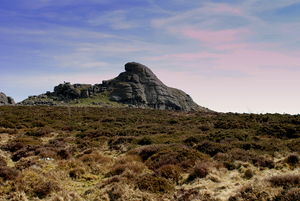Dartmoor
Dartmoor is an area of moorland in the county of Devon in south-west England, characterised by gentle slopes, granite tors and high rainfall creating much boggy ground. It is designated as a National Park. The highest points are High Willhays (621m or 2039 ft) and Yes Tor (619m or 2030 ft) near to each other on the north-west edge.[1]
The moor has been intensively used since at least the Bronze Age, without being intensively settled. This has resulted in the survival of many sites of archaeological interest. The acid soil has destroyed much of the evidence in sites of human habitation and interment, but there are significant remains of settlements, burials, stone rows, old boundaries, farming, warrening, tinning, mining for tin and other metals, peat extraction, quarrying, water extraction, and other activities.[2] There are many leats (artificial watercourses), constructed to bring water or water power to where it was needed.
The area covered by the National Park is 954 sq km (368 sq miles). Within this are several villages or small towns, the total population being estimated at around 34,000. The National Park Authority itself is responsible for planning, conservation, promotion of public access and some other functions. Other local authority services are provided by Devon County Council or the three district authorities which cover the area. The ownership of the land is varied. The Ministry of Defence carries out military training on 12,906 hectares (31,891 acres), of which 10,871 hectares (26,862 acres), known as the Defence Training Estate, is owned or leased by it. Just under half of the National Park is estimated to be moorland, the remainder being mostly farmland.[3]
Dartmoor is known for its ponies which roam freely on the moor. The ponies are semi-wild, but all have owners. Archaeological findings have shown that there were domesticated ponies about 3,500 years ago, and the earliest written record (a reference to wild horses owned by the Bishop of Crediton) dates from 1012. The numbers have reduced in recent years to about 3,000.[4]
The Sherlock Holmes story, The Hound of the Baskervilles was set on Dartmoor. Conan Doyle, who had been a GP in nearby Plymouth, stayed at a hotel in Princetown at the centre of the Moor, and was said to have had Foxtor Mire in mind when writing of the Great Grimpen Mire.
Dartmoor Prison
Dartmoor Prison started as part of Sir Thomas Tyrwhitt's project to develop Dartmoor. He committed himself to developing Princetown as a centre for the moor, it being adjacent to his new house at Tor Royal, and named in honour of the Prince Regent, a friend of his. In 1805 he persuaded the government of the desirability of using Princetown for building barracks for French prisoners of war, many of whom had been confined in hulks on the nearby river Tamar. Building started in 1806, to a radial design based on continental models and later advocated by Jeremy Bentham as the Panopticon,[5] except that the spokes of the wheel were supervised from the perimeter wall rather than from the central point.[6] After 1850 it became a prison for those serving long-term sentences. Despite its isolated location there have been several notorious escapes.
